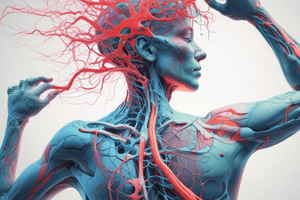Podcast
Questions and Answers
Which of the following is NOT a primary way that neuroscience research is done?
Which of the following is NOT a primary way that neuroscience research is done?
- Experimental approaches
- Recording neural activity
- Computational modeling
- Brain stimulations (correct)
The reflex arc involves conscious decision-making by the brain.
The reflex arc involves conscious decision-making by the brain.
False (B)
Name one model organism commonly used in neuroscience research.
Name one model organism commonly used in neuroscience research.
Drosophila or C.elegans
The brain's system of fluid-filled spaces is known as the _________ system.
The brain's system of fluid-filled spaces is known as the _________ system.
Match the following research methods with their general description:
Match the following research methods with their general description:
Which of the following is NOT considered one of the major scales of investigation in neuroscience?
Which of the following is NOT considered one of the major scales of investigation in neuroscience?
Bipedalism is not thought to be related to the development of human cognitive capacity.
Bipedalism is not thought to be related to the development of human cognitive capacity.
Name one of the major brain structures.
Name one of the major brain structures.
Flashcards
What is neuroscience?
What is neuroscience?
The study of the nervous system, encompassing its structure, function, development, and disorders.
Why is neuroscience interdisciplinary?
Why is neuroscience interdisciplinary?
Neuroscience draws insights from multiple disciplines, like biology, chemistry, psychology, and computer science.
How is neuroscience studied?
How is neuroscience studied?
Neuroscience uses various techniques to study the nervous system, from examining brain activity to observing behavior.
What is a reflex arc?
What is a reflex arc?
Signup and view all the flashcards
What are the anatomical axes of the brain?
What are the anatomical axes of the brain?
Signup and view all the flashcards
What is the cerebral cortex?
What is the cerebral cortex?
Signup and view all the flashcards
What is synaptic integration?
What is synaptic integration?
Signup and view all the flashcards
What are model organisms in neuroscience?
What are model organisms in neuroscience?
Signup and view all the flashcards
Study Notes
Neuroscience
- Neuroscience is an interdisciplinary field, studying neural phenomena from molecular to behavioral levels.
- Investigation is done at various scales:
- Molecular level: Proteins, ion channels
- Cellular level: Specialized structures like hair cells
- Neural activity: Individual neuron responses
- Circuit/computation level: Coordinated neuron activity
- Anatomical level: Neural connections
- Behavioral level: Observable responses
- Research lenses include:
- Mechanistic: Physical function of systems
- Computational: Information processing in neural circuits
- Developmental: Neural system formation
- Evolutionary: Comparative analysis between species
- Genetic: Role of genes in neural function
- Cognitive: Mental processes
- Medical: Treatment and neural tissue regeneration
Research Methods
- Recording Neural Activity:
- Electrophysiology: Measures voltage and current changes
- fMRI: Measures blood flow as an indicator of neural activity
- Calcium imaging: Observes cellular activity using fluorescence
- Experimental Approaches:
- Lesion studies: Examining behavioral changes after damage to identify necessary brain regions. (e.g., Broca's area and language)
- Neural manipulation: Using optogenetics to control neural activity or employing neurotoxins to block neurotransmitter release (e.g., light-activated ion channels in transgenic animals).
Brain Structures and Functions
- Major Components:
- Thalamus: Relays sensory information
- Hypothalamus: Homeostatic functions
- Amygdala: Processes fear
- Brainstem: Controls homeostatic functions
- Cerebellum: Adapts motor patterns
- Corpus Callosum: Connects hemispheres
- Basal Ganglia: Initiates motor patterns
- Somatosensory Cortex: Processes body sensations
- Visual Cortex: Processes vision
- Motor Cortex: Controls muscle activation
- Brain Matter Organization:
- White Matter: Axons, neural highways
- Gray Matter: Cell bodies, dendrites, glia
- Ventricular System: Four interconnected ventricles filled with cerebrospinal fluid (CSF).
Neural Circuits and Communication
- Reflex Arc: Simple neural circuit example (knee-jerk reflex). Sensory neuron → detects stimulus → activates motor neuron → causes muscle response.
- Information Flow:
- Afferent: Signals from PNS to CNS (sensory info)
- Efferent: Signals from CNS to PNS (command signals).
- Circuit Motifs:
- Feed-forward excitation
- Diverging pathways (one signal to multiple targets)
- Converging pathways (multiple inputs integrate)
- Feedback excitation
- Feed-forward/feedback inhibition
- Cross inhibition (mutual inhibition between pathways)
- Disinhibition (inhibiting inhibitory signals)
Neuroanatomical Navigation
- Anatomical Axes: Rostral/Anterior (toward head), Caudal/Posterior (toward tail), Dorsal (toward back), Ventral (toward belly)
- Anatomical Planes: Horizontal, Coronal, Sagittal
- Major Brain Structures: Cerebral cortex divided into lobes (frontal, parietal, temporal, occipital), six-layered neocortex; motor, somatosensory, visual, and auditory cortices. Cerebellum, thalamus, hypothalamus, and brainstem also discussed.
Glial Cells
- Types and Functions: Ependymal cells (manage cerebrospinal fluid), Astrocytes (maintain blood-brain barrier), Oligodendrocytes/Schwann cells (provide myelination), Microglia (immune cells).
Evolutionary Development
- Pre-neural light detection: Single-cell organisms using channelrhodopsins.
- Neural signaling evolution: Basic cellular components adapted for neural function.
- Comparative neurobiology: Species-specific adaptations (e.g., food caching birds, star-nosed moles).
Model Organisms
- Drosophila (fruit fly): Used to study courtship behavior, neural circuits.
- C. elegans (roundworm): Simple yet multifunctional neural circuits.
Human Cognitive Capacity
- Brain size relative to body weight is not the key differentiator for higher cognitive abilities
- Neocortex development is crucial (extensive gyrification increases cortical surface area).
- Approximately 15 billion cortical neurons.
Cultural Factors
- Cultural inheritance as key evolutionary component
- Complex interaction between biological and cultural evolution, focusing on neural systems and conservation across species.
Comparative Studies
- Comparative studies between related species.
- Use of model organisms with simpler nervous systems, investigations into evolutionary adaptations.
Studying That Suits You
Use AI to generate personalized quizzes and flashcards to suit your learning preferences.





